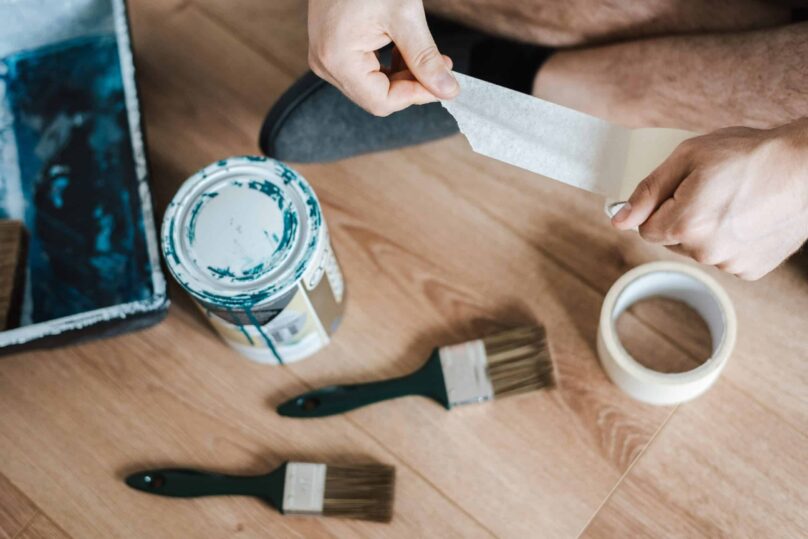The main problem with paint interior doors -or indeed any woodwork with a large surface area-involves keeping what professional decorators call a wet edge. Obviously, the door has to be painted bit by bit, and if the edge of one area begins to dry before this is joined up to the next area, the join will show when the paint dries completely.
The secret of success is to flush and sequence, as shown in the accompanying drawings of flush and paneled doors, and to complete the job in one continuous operation, working as fast as reasonably possible.
Before starting to paint a door, wedge it open so there is room to walk through the doorway without touching wet paint, and also so that the hinged edge of the door can be reached easily.
Remove handles, locks, and another fitting; wedge a length of dowel in the latch hole to make a temporary handle for use until the paint has dried. Slide a dust sheet underneath the door to catch any drips. Finally, warm everyone else in the house that the door is covered with wet paint, and keep children and pets out of the way in another room or out of doors.
Painting flush doors
- Remove the door furniture and wedge the door open. Then divide it up into eight or ten imaginary squares, and start painting at the top of the door by filling in the first square. Brush the paint out towards the door edges so it does not build up on the external angles.
- Move on to the next block at the top of the door, brushing paint out towards the top and side-edged as before. Carefully blend the two areas together with horizontal brushstrokes, then with light vertical laying-off strokes.
- Continue to work down the door surface block by block, blending the wet edges of adjacent blocks together as they are painted. Always aim to complete a flush door in one session to prevent the joints between blocks from showing up as hard lines. Replace the door furniture when the paint is touch-dry.
Painting paneled doors
- Tackle paneled doors by painting the moldings. Around the recessed panels first. Take care not to let paint build up in the corners or to stray onto the faces of the cross-rails at this stage. Then paint the recessed panels.
- Next, paint the horizontal cross-rails, brushing lightly inwards towards the painted panel moldings to leave a sharp paint edge. Feather the paint out thinly where it runs onto the vertical stiles at each end of the rails.
- Finish the door by painting the vertical center rail, and the outer stiles, again brushing towards the panel moldings. Where the rail abuts the cross-rails, finish with light brushstrokes parallel to the cross-rails.
Painting door edges
Where the two faces of a door are being painted in two different colors, the convention is to match the color of the hinged edge to that of the closing face of the door-the one facing the next room-and to paint the leading edge to match the other door face.
Varnishing wood
- On bare wood, use a clean lint-free cloth to wipe the first coat onto the wood, working along the grain direction. This coat acts as a primer/sealer.
- Sand the first coat lightly when dry to remove any ‘nibs’ caused by dust particles settling on the wet varnish, then wipe off the sanding dust.
- Apply the second and subsequent coats of varnish with a brush, applying it along the grain and linking up adjacent areas with light brush strokes.
Conclusion
The next step is to be able to properly plan your painting process. With this knowledge in hand, you can begin to paint the interior doors of your home. With some practice, you can be able to paint all the door sizes that are needed for your specific project. Lastly, be sure to use good techniques when painting Interior Doors. Avoid common mistakes such as using too much paint or using the paint in a specific spot.
FAQ
Do you have to sand interior doors before painting?
as different people may have different opinions on how to sand interior doors before painting. However, some tips on how to sand interior doors before painting may include using a quality sandpaper, using aFK sandpaper, or using a fabric patching stick.
Is it better to paint doors with a brush or roller?
as it depends on personal preference and what the artist feels is safety-safe. However, for regular people, it is often easier to use a brush for painting doors with. This is because a brush is not potentially dangerous like a hand tool, which can easily miss small objects in front of it. Additionally, a roller is more comfortable and easy to use for both women and men.
Do you paint both sides of interior doors?
If you paint both sides of interior doors, your work will be more efficient and you will have more control over your work being seen by many people.

